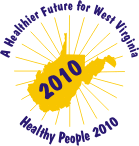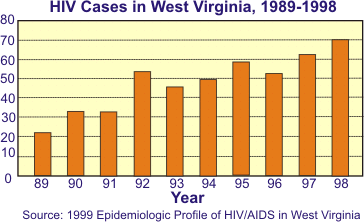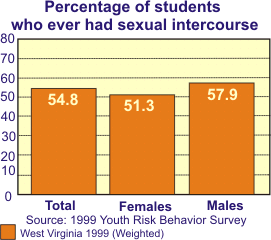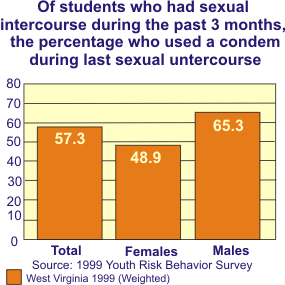A Healthier Future for West Virginia - Healthy People 2010
Federal 2010 Initiative
|
Contents Message Credits Objectives |
|
| 1 2 3 4 5 6 7 8 9 10 11 12 13 14 15 |
16 17 18 19 20 21 22 23 24 25 26 27 28 29 |

13 - HIV
Background
The HIV/AIDS epidemic was first recognized in the states of New York
and California in 1981. In the early years of the epidemic, the majority
of cases occurred in white men who have sex with men. However, as time
has passed, cases have appeared among persons who inject illegal drugs,
heterosexuals, and racial minorities. West Virginia first required AIDS
reporting in 1984. Since then, 87% of West Virginia's cases have occurred
in men and 13% in women. West Virginia was five years into the epidemic
before females accounted for more than 10% of the reported cases. When
observing the risk behaviors for acquiring AIDS among males, just as observed
nationally, men who have sex with men account for the majority of cases
(65%), followed by injecting drug users (14%). Injecting drug use was
observed with even greater frequency among females (38%), following heterosexual
contact (44%) as a major risk behavior. Injecting drug use was the most
common risk factor reported by African American females.
By the 1990s many changes began to occur in the epidemic. In 1992, AIDS became a leading cause of death among Americans aged 25-44 years of age. By the end of 1999, a total of 733,374 AIDS cases had been reported in the United States, of which 1,008 were reported in West Virginia. By 1998, nationally, as well as statewide, the number of new cases began to decline. These declines can be attributed to advances in antiretroviral therapies (CDC, 1999 HIV/AIDS Surveillance Report) and to the many HIV prevention efforts implemented across the country.
West Virginia made HIV a required reportable condition in 1989. Active surveillance activities continue to monitor the status of reported cases to determine if a change from HIV to AIDS has occurred. With the introduction of new medications to treat HIV disease, these data will increase in importance as an indicator of progression of HIV-related infection to disease. It is speculated that the period of time from HIV to AIDS will widen, as has been shown with the use of protease inhibitors and other new therapies that promise to lengthen the life span of individuals living with HIV.
In spite of the many successes in HIV/AIDS surveillance, prevention, and careactivities, there are still many challenges facing the West Virginia AIDS Program with this epidemic. The demographics of the people who need to be reached by prevention efforts have changed. Women, youth, and racial minorities account for a growing proportion of new HIV cases. The face of the HIV data is constantly changing. When individuals reported with HIV are diagnosed with AIDS, the case is removed from the HIV data set and added as an AIDS case. There are many differences in HIV and AIDS reported cases. Women are 28% of the HIV reported cases but only 13% of the AIDS cases. The 20-29 age group represents the largest proportion of reported HIV infection cases, with 39% of the reported cases, but only account for 18% of AIDS cases. African Americans represent 37% of the HIV reported cases and 18% of AIDS cases. This is an alarming statistic since African Americans account for only 3% of West Virginia's population.

The objectives selected for West Virginia in this chapter were identified to address the areas of greatest potential for preventing HIV-related disease.
Top of PageThe Objectives
OBJECTIVE 13.1. Confine annual number of diagnosed HIV infection in adolescents and adults to no more than 50 cases. (Baseline: 70 cases in 1998)
Data Source: West Virginia Bureau for Public Health (WVBPH), Office of Epidemiology and Health Promotion (OEHP), AIDS Program
The epidemic curve of reported HIV infection cases by year of report 1989 through 1998 is displayed in the chart on the previous page. Four hundred eighty-four cases are displayed during this time period. HIV cases have gradually increased in the last six years with a slight decline in 1996. (Annual rates are not routinely calculated for HIV in West Virginia because case counts are believed to be less complete than reported cases of AIDS. This can result from persons not knowing that he or she is HIV positive, or he or she may be asymptomatic and may not have been tested for HIV. The data cited in the Background section of this chapter are cumulative due to the small numbers of annual reported HIV cases.) Continual efforts are being made to encourage HIV testing among persons engaged in high risk behaviors.
OBJECTIVE 13.2.
13.2a. Decrease the number of high
school students who are sexually active to less than 45%. (Baseline: 54.8% in 1999)
13.2b. Of high school students who
are sexually active, increase the percentage reporting condom usage to 65%. (Baseline: 57.5% in 1999)
Data Source: WV Department of Education (WVDOE), Youth Risk Behavior Survey (YRBS)


The preceding two graphs display the results of the 1999 West Virginia Youth Risk Behavior Survey. Sexual intercourse was reported more frequently in males (57.9%) than females (51.3%). Not shown is that sexual activity increases with age when observing the trend from 9th to 12th grade. The West Virginia AIDS Program works very closely with the West Virginia Department of Education, Office of Healthy Schools, to address this growing problem among high school students. WV HIV data indicate that disease is occurring in this population and the risk of transmission continues to be a concern with the increase of sexual activity. When reviewing sexually transmitted disease (STD) data, 41% of all reported cases of chlamydia and over 30% of gonorrhea cases were among the 15-19 age group. These data document that high school students are sexually active and acquiring STDs, including HIV. Educating this population to protect themselves by consistently using condoms and not engaging in high risk behaviors is a priority for the AIDS and Healthy Schools Programs.
OBJECTIVE 13.3. Increase the number of injecting drug users (IDUs) tested for HIV to 250 per year. (Baseline: 109 in 1999)
Data Source: WVBPH, OEHP, AIDS Program, AIDS Prevention Center (APC) HIV testing database
The AIDS Program is initiating a new project to increase HIV testing and counseling of injection drug users (IDUs) and other high risk populations who are not currently coming to AIDS Prevention Centers. The method being used is an outreach approach for counseling and a non-invasive HIV test, Ora-Sure. Guidelines have been developed by a work group including the AIDS Program, community planning groups, and community-based organizations (CBOs). A request for proposals was mailed to all CBOs; six responded. The six CBOs are diversely located throughout the state, and all should receive funding to be included in this project. IDUs have been a very difficult risk behavior group to reach and this new Street Outreach HIV Counseling and Testing Project will help address that need.
FLAGSHIP OBJECTIVE
OBJECTIVE 13.4. Increase to 60% the proportion of correctional facilities offering HIV counseling and testing to inmates exiting the correctional system. (Baseline: 20% in 2000)
Data Source: WVBPH, OEHP, AIDS Program, HIV and Corrections Project
The correctional system in West Virginia includes 11 state prison facilities for adults (eight prisons, one DUI center and two work release centers), seven state juvenile detention centers, and seven regional jails (with two additional regional jails under construction and one with the site yet to be determined).
At present, inmate access to HIV counseling and testing in West Virginia correctional facilities is on a voluntary basis upon inmate request or clinical indication. The WV Bureau for Public Health is currently (summer/fall 2000) in the process of implementing a pilot collaborative venture with the WV Division of Corrections to enhance HIV counseling, testing, and referral services for inmates in five adult (state prison) correctional facilities prior to their exit from the correctional system and back into the community. Inmates in the five pilot facilities, who are within 30 to 60 days of discharge, parole, or transfer to a work release center will be offered HIV counseling and testing, as well as testing for syphilis and hepatitis B. Inmates found to be HIV positive will be linked to HIV community case management services prior to their release.
The pilot program will be evaluated for effectiveness at the conclusion of the first year of operation for purposes of expanding this project to inmates in other WV correctional facilities.
OBJECTIVE 13.5. By 2010 all public health districts will have had at least six youth peer educators trained who will provide peer education programs designed to reduce risk among high school students. (Baseline: Two students trained per public health district in 1998)
Data Sources: WVDOE progress reports; WVBPH, OEHP, AIDS Program
West Virginia's youth peer education project began in 1997 as a collaborative project with the Department of Education and with a goal of training one school in every public health district. More than 100 students have been trained to date to conduct peer education training in the eight public health districts. Peer education training has focused on high risk youth populations in four different juvenile correctional centers.
OBJECTIVE 13.6.
13.6a. Increase the interval between the first positive HIV test and AIDS diagnosis to 48 months. (Baseline: median interval of 41.5 in 1995-1999)
13.6b. Increase the interval between AIDS diagnosis to death to 36 months. (Baseline: 21 months in 1995-1999)
13.6c. Decrease the percent of patients diagnosed with AIDS at first HIV diagnosis to less than 20%. (Baseline: 28.5% in 1995-1999)
Data Sources: WVBPH, OEHP, HIV/AIDS Reporting System and APC HIV counseling and testing database
The impact of the new combination drug therapies was first observed in West Virginia's data in 1998, when AIDS deaths declined for the first time since 1992. (There was a single year decline due to an artifact of reporting in 1994.) This decline has continued since then with deaths attributable to AIDS down 66% in 1999. These surveillance data indicate a delay in the progression to death from AIDS as well as a progression from HIV infection to AIDS. These three objectives will provide insight into population groups that are not receiving treatment. They will also assist with targeting HIV/AIDS prevention efforts in groups currently being impacted disproportionately by this epidemic (minorities, female injecting drug users, etc.).
Identifying HIV infection as early as possible and referring for HIV care improves the prognosis. This continues to be an objective that will depend on treatment advances and access to care. West Virginia's counseling and testing activities will play a major role in the success of these objectives.
Meeting the Objectives
- Health Promotion Channels for Achieving Objectives:
- Worksites
- Schools
- Public Health Programs
- Networks
- Health Care System
- Higher Education
The following list includes some of the organizations that will be leading the initiatives to reach the 2010 objectives:
- HIV Community-Based Organizations
- HIV Community-Planning Organizations
- Schools
- Youth Peer Educators
- Public Health AIDS Prevention Centers
- Health Care System
- Higher Education-Office of Healthy Schools
- WV Department of Corrections
- WV AIDS Program
- WV HIV Care Consortia
Work Group Members
Loretta Haddy, MA, MS, Work Group Leader, State Epidemiologist,
Director, Division of Surveillance and Disease Control, WVBPH
Tim Dotson, Youth Peer Educator
Wes Farr, MD, Department of Medicine, West Virginia University
Joyce Litton, Caritias House
Karen Villanueva-Matkovich, Assistant Public Defender
Greg Moore, STD Program, WVBPH
Martha Phillips, Coordinator, Office of Healthy Schools, WVDOE
Richard Williams, Concerned citizen
Julie Britton, Covenant House
Terri Kessel, Concerned citizen
Thomas Rushton, MD, Marshall University
References/Resources
U.S. Department of Health and Human Services. Healthy People 2010 (Conference Edition, in Two Volumes). Washington, D.C.: January 2000.
West Virginia Bureau for Public Health. West Virginia HIV/AIDS Epi Profile, 1998. Charleston, WV: West Virginia Department of Health and Human Resources, 1998.
West Virginia Office of Healthy Schools. West Virginia Youth Risk Behavior Survey. Charleston, WV: West Virginia Department of Education, 1999.
For More Information
Division of Surveillance and Disease Control
Office of Epidemiology and Health Promotion
Room 125
350 Capitol Street
Charleston, WV 25301-3715
Phone: (304) 558-5358; Fax (304) 558-6335
This page was last updated June 21, 2001.
For additional information about HP2010, contact Chuck Thayer at (304) 558-0644
or Chuck.E.Thayer@wv.gov